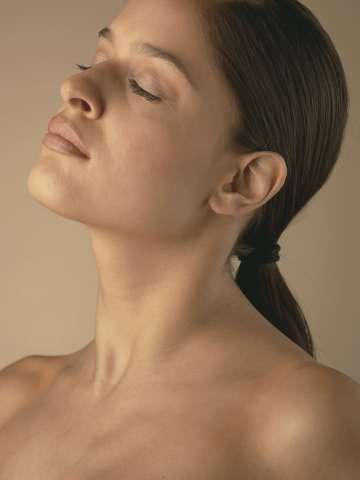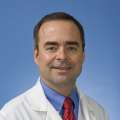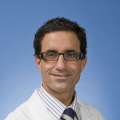Facial Plastic Surgery and Rejuvenation
From minimally invasive surgeries to reconstructive procedures, our team delivers high-quality, advanced care.


Why choose UCLA Health for facial plastic surgery?
At UCLA Health, we have one of the nation’s leading programs in aesthetic and reconstructive surgery focusing solely on the face and neck. From minimally invasive and noninvasive procedures to the most complex facial surgeries, our goal is to improve your quality of life.
Highlights of our program include:
Established expertise: All our facial plastic surgeons are board certified by the American Board of Facial Plastic and Reconstructive Surgery. This means we can offer the highest level of expertise in face and neck surgery. We have pioneered many of the procedures used today in facial cosmetic surgery and our combined experience totals more than 50 years of practice.
Unparalleled success rate: We lead the nation with an unsurpassed 99.5% success rate in free flap surgery, in which we transplant tissue from one part of your body to another. Our surgeons have performed thousands of these procedures over the past several decades.
Groundbreaking treatments: You have access to a full spectrum of treatments, from cosmetic procedures to treatment for facial paralysis. Our surgeons continually advance the field of facial plastic surgery and performed the first total face transplant surgery on the West Coast.
Increased access to care: We aim to deliver high-quality care in ways that are most convenient and accessible for you. We offer telemedicine consultations during which you can meet with your provider via a secure video connection from the comfort of your home or anywhere you choose.
Our areas of care
Our facial plastic surgeons offer a number of treatments that help you look and feel your best. Our areas of care include:
Cosmetic surgery
Cosmetic surgery can help you attain a more youthful and energized appearance. We strive to ensure you have no obvious signs of surgery while achieving your ideal look. Whether you want a mole removed, your nose refined or your neck tightened, our facial plastic and reconstructive surgeons can help.
Noninvasive facial rejuvenation
We also offer state-of-the-art rejuvenation treatments such as botulinum toxin injections, dermal fillers or micro-needling. Our team works with you to assess your specific needs, providing a highly personalized and targeted care plan to improve your complexion.
Reconstructive surgery
We are pioneers and national leaders in face and neck reconstructive surgery. We focus on treating patients who have congenital, acquired and post-cancer irregularities of the face and neck. Our highly skilled surgeons aim to restore natural form and function so you can live a high quality of life.
Facial Nerve Center
A dedicated team of experts treats conditions that cause facial paralysis. We offer advanced surgical options to improve facial function and aesthetics. Our surgeons work to restore meaningful and expressive facial movements while also performing eyelid surgeries to protect your eye health.
Face Transplantation Program
The Face Transplantation Program is the first of its kind on the West Coast and one of only a handful in the United States . A facial transplant can offer hope and healing to patients who have suffered devastating and severe facial disfigurement.
Not only do we aim to restore function in terms of breathing, speaking and eating, but we also understand how closely identity and self-esteem can be tied to your facial experience. An extensive range of subspecialists help patients adjust physically and emotionally after face transplant surgery.
Conditions we treat
We perform plastic facial and reconstructive surgery to treat a range of conditions, including:
- Burns
- Facial irregularities that are present at birth (congenital)
- Post-cancer surgical defects
- Traumatic injuries
Our facial plastic surgeons also treat facial paralysis, which could be caused by:
- Bell’s palsy, a condition that causes sudden, unexplained episodes of facial weakness or paralysis
- Traumatic injuries
- Tumor-removal surgery
We also offer a variety of noninvasive and cosmetic procedures to help you achieve your desired appearance. You may want to look more youthful, refine your complexion or minimize wrinkles. Whatever your needs and goals, our surgeons help you find the treatment that’s right for you.
Treatments facial plastic surgeons offer
We offer an extensive range of surgical and nonsurgical treatments for a variety of needs, including:
Noninvasive facial rejuvenation
Noninvasive facial rejuvenation may include:
Botulinum toxin injections: Botulinum toxin (Botox®) injections can help reduce the appearance of fine lines and wrinkles. The doctor uses a thin needle to inject small amounts of botulinum toxin beneath the skin. Patients usually notice results in a few days, and results often last three months or longer.
Fillers: Facial fillers, also called dermal fillers, are injections of hyaluronic acid, calcium hydroxylapatite, poly-L-lactic acid or other safe, gel-like substances. They restore fullness to the face, reduce the appearance of wrinkles or plump thin lips.
Chemical peels: The provider applies a thin layer of a chemical solution to the skin. The chemical gently removes the top layer of skin to reveal more youthful, smoother skin underneath. Some people need several chemical peels to achieve their desired results.
Micro-needling: This treatment stimulates the production of collagen, a protein in connective tissue that helps with skin elasticity. The provider uses tiny, sterilized needles to make small pricks in the skin. These small pricks cause the body to produce more collagen, helping create a more youthful appearance.
Platelet-rich plasma facial: Sometimes called the “vampire facial,” platelet-rich plasma (PRP) can help reduce wrinkles, decrease scarring and improve your complexion. A specialist takes a small blood draw and places the blood in a machine called a centrifuge. The centrifuge separates the blood into its components. Then the provider injects a high concentration of platelets back into the face. Patients usually notice results within several weeks.
Facial cosmetic surgery
Cosmetic procedures include:
Blepharoplasty: Commonly known as eyelid surgery, blepharoplasty improves the appearance or function of the upper or lower eyelids, or both. The surgeon makes small incisions around the eyes to remove excess skin, reposition fat or tighten muscles. They aim to make the incisions around the natural folds of the eyelid so that scars aren’t noticeable after surgery.
Brow lift: Also known as a forehead lift, a brow lift helps improve frown lines, reduces forehead wrinkles and lifts the eyebrows into a more alert position. Depending on the surgical technique, the surgeon typically makes an incision around either the top of the head or the hairline. Then they adjust tissue and muscle beneath the skin.
Hair transplant: A hair transplant may treat bald or thinning hair. The surgeon uses micrografts of one to three hairs taken from the back or side of the head. They place the grafts on bald or thinning areas of the patient’s scalp. This procedure is known as a follicular unit extraction (FUE). Our physicians use a feathering technique to place single hair grafts at the front of the hairline with two- or three-hair grafts toward the back of the hairline. This approach adds fullness and density to the hairline while giving it a soft, natural appearance. It may take several hair-transplant surgeries to achieve desired results.
Rhinoplasty: Sometimes called a nose job, rhinoplasty changes the shape or improves the function of the nose. The surgeon typically goes through a small incision at the base of the nose to remove, add or reposition bone and cartilage.
Rhytidectomy: Commonly called a facelift, rhytidectomy may improve physical signs of aging in the face and neck. During a traditional facelift, the surgeon makes an incision around or near the hairline. The incision extends from the temples to the front of the ears, and then behind the ears to the lower scalp. They may also need to make a second incision under the chin. For a mini-facelift, the surgeon uses a limited incision technique that runs along the front of the ears and just behind them. They tighten the muscles and tissues beneath the skin, and may also remove or redistribute fat in the face or neck. Then they remove excess skin, re-drape the skin over the face and stitch the incisions closed.
Facial nerve and paralysis treatment
Facial nerve and facial paralysis treatments may include:
Noninvasive treatments: Botulinum toxin or steroid injections to reduce swelling may be effective treatments for facial nerve problems and facial paralysis.
Direct nerve repair: The surgeon reconnects healthy ends of a damaged nerve. This treatment may be effective if a patient has an injury in a small portion of the facial nerve.
Nerve graft: The surgeon takes a small piece of nerve from elsewhere in the body and places it in the face. They may use this technique if the two damaged ends of the nerve are too far apart to reconnect. The graft is like a small bridge to connect the two ends.
Nerve transfer: The surgeon takes a healthy functioning nerve from a donor and transfers it to the patient.
Hypoglossal nerve transfer: The hypoglossal nerve controls movement in the tongue for swallowing and speaking. The surgeon creates a small cut in the hypoglossal nerve and attaches it to facial nerves. This partial cut allows nerves to grow into the hypoglossal nerve without damaging its function.
Masseteric nerve transfer: The masseteric nerve is one of the nerves that extends from the ear through the cheek and jaw. The surgeon can connect the masseteric nerve to another facial nerve that controls smiling. After surgery, patients can bite down to smile. They typically go through rehabilitation and retraining to get used to this movement.
Eyelid and eyebrow procedures: Our surgeons use a variety of eyelid or eyebrow surgeries to treat facial nerve problems. They may tighten the lower eyelid (canthoplasty) or perform a brow lift to adjust tissue and muscle beneath the skin.
Temporalis tendon transfer: The temporalis muscle runs along the side of the head and attaches to the jaw to assist with chewing. The surgeon may attach a portion of the temporalis tendon, the connective tissue attached to the temporalis muscle, to the corner of the mouth. This can help improve facial symmetry, chewing and speech functions.
Gracilis muscle free tissue transfer: The gracilis muscle runs along the inside of the thigh. Surgeons may use a gracilis muscle transfer for patients who have had facial paralysis for more than two years with no improvement. They remove a segment of the gracilis muscle, along with surrounding tissue, nerves and blood vessels, and attach it to the masseteric nerve. This improves facial symmetry and smile function.
Facial reconstructive surgery
We focus on face and neck irregularities that were present at birth (congenital), developed later in life (acquired) or are the result of skin cancer surgery. Reconstructive surgeries include a range of complex procedures in which a plastic surgeon reconstructs parts of your face, such as your nose, mouth or eye sockets. Facial reconstructive techniques may include:
Cartilage grafting: The surgeon collects cartilage, a firm but flexible connective tissue, from somewhere else in the body. Then they use the cartilage to reconstruct areas of the face. Facial plastic surgeons often use this technique to reconstruct the nose when patients have deformities due to cancer defects, burns or traumatic injuries.
Skin grafting: The surgeon removes a healthy piece of skin from one part of the body and transfers it to the face. They may use skin grafting to treat cancer defects, burns or other injuries.
Tissue rearrangement: Sometimes called tissue transfer, tissue rearrangement uses healthy tissue and skin from elsewhere in the body to reconstruct facial defects. The transferred skin is called a skin flap. We use a range of skin flap techniques, including advanced ones such as rotation flaps, to reconstruct the nose, jaw, mouth, eyes and cheekbones. The surgeon may use a tissue transfer to treat burns or severe traumatic injuries to the face.
We also specialize in advanced procedures such as:
Microvascular reconstruction: Microvascular surgeries involve transferring skin, bone and tissue along with blood vessels. It is one of the most advanced techniques for facial reconstruction. In addition to positioning a skin flap, the surgeon uses a microscope to connect the blood vessels in the skin flap to the blood vessels in the face. To do this, they use sutures thinner than the width of a human hair. Microvascular surgery reestablishes blood flow to the skin flap, which increases the chances of a successful outcome.
Reconstruction of Mohs surgery defects: Mohs surgery involves removing thin layers of skin until the surgeon completely removes skin cancer. After Mohs surgery, however, many patients have a large wound on their face that requires reconstruction. Our plastic surgeons use a variety of reconstructive techniques, depending on the location and size of the surgical defect. Common techniques include skin and cartilage grafting.
Facial transplant surgery
A face transplant is a highly complex, groundbreaking procedure. During the operation, the surgeon replaces all or a portion of the face with donor tissue.
A facial transplant can significantly improve quality of life and function for patients who have experienced severe burns, traumatic injuries or diseases. UCLA Health is one of only several medical centers in the U.S. that offers this advanced treatment option.
Meet our team
Our facial plastic surgeons are world-class experts in facial plastic and reconstructive surgery. We offer a spectrum of advanced treatments to improve facial appearance and function. Whether you have a facial nerve condition or want a more youthful complexion, our renowned specialists can help.
Contact us
Call 310-794-0239 to request an appointment with a facial plastic surgeon at UCLA Health.
Find your care
Our facial plastic surgeons offer a wide range of complex treatments to improve your quality of life. Call 310-206-6688 to learn more about facial plastic surgery at UCLA Health.





